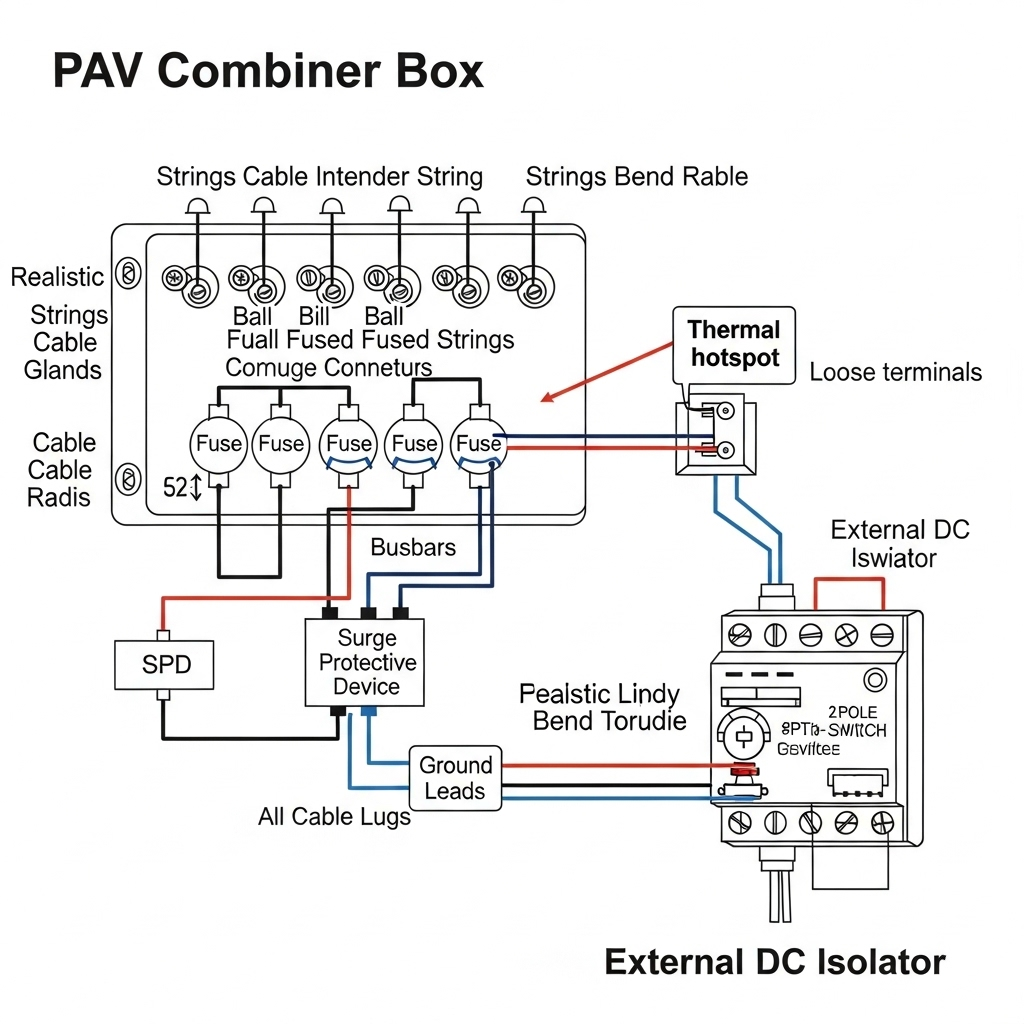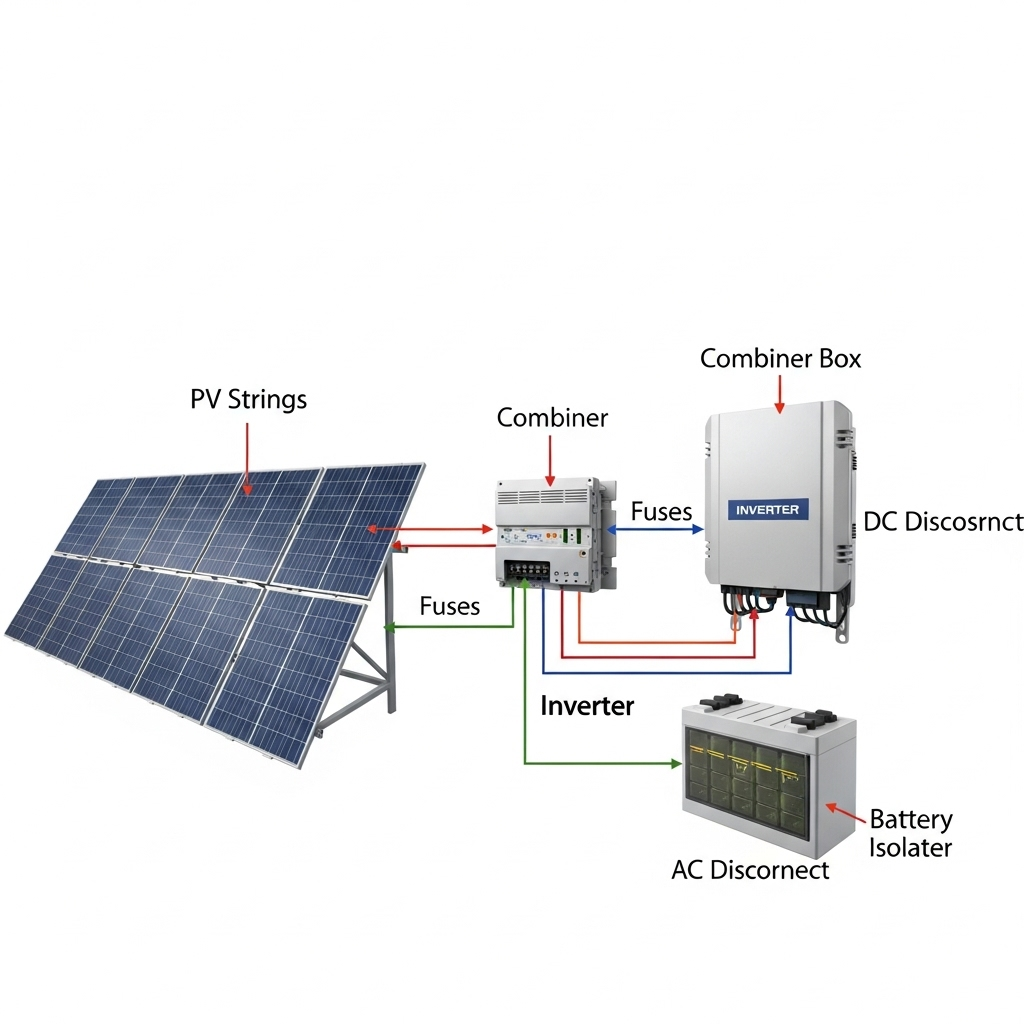Small wiring errors inside PV combiners, isolators, and DC disconnects cause outsized losses. They trigger nuisance trips, hot spots, and hard-to-trace faults. This piece pinpoints seven frequent PV combiner box wiring mistakes and solar isolator wiring errors, then gives DC disconnect wiring best practices you can apply on any site, from small rooftops to utility-scale fields.
Balance-of-system reliability matters. As noted in Solar Energy Perspectives, the balance of system includes inverters, protection devices, wiring, and monitoring. These parts set day-to-day uptime. For distributed PV, System Integration of Renewables highlights that better screening and practices reduce risk on distribution circuits. Bringing that mindset into combiner wiring reduces trips and improves safety. Codes evolve too. Getting Wind and Solar onto the Grid shows how requirements adapt to keep systems stable during disturbances. Your isolators and disconnects must match those expectations. For safety basics and technology pathways, see U.S. DOE Solar Energy, and for market data and trends that push reliability, see EIA and IRENA.
Mistake 1: Crossed polarity and mixed string configurations
What goes wrong
Polarity reversals at the combiner input landings or at the isolator line/load side are common PV system wiring issues. A single crossed string can drive a reverse-bias stress on diodes and produce a high current fault. Mixing strings with different module counts or orientations into one combiner input creates unequal Voc and current sharing.
How to catch it fast
- Label both ends of every string. Use permanent tags with string ID, polarity, and source.
- Measure Voc and Isc per string at the box. Readings should be consistent for strings in the same plane and temperature.
- Verify isolator line vs. load orientation with a continuity test (isolator open) and a polarity check (isolator closed).
Wiring best practices
- Keep arrays homogeneous per combiner input: same module count, tilt, and azimuth.
- Use color coding (red/black or brown/blue) and ferrules where allowed. Prevent stray strands.
- Add a pre-energization checklist that records string Voc within a narrow band (for example, within ±3% across a group in similar conditions).
Mistake 2: Under‑torqued or over‑torqued terminations
What goes wrong
Loose lugs heat under current. Over‑torqued lugs damage strands and reduce contact area. Both create hot spots on busbars, fuse holders, and isolator poles. Field thermography often finds a few degrees rise on a good joint and tens of degrees on a poor joint.
How to catch it fast
- Use a calibrated torque tool per manufacturer spec on every screw, stud, and compression lug.
- Infrared scan at commissioning and during midday peak irradiance on a clear day. Record deltas; anything above a modest rise against ambient is a trigger for rework.
Wiring best practices
- Never double‑lug conductors in a terminal not rated for two wires.
- Observe conductor prep: correct strip length, clean copper, and the right lug barrel size.
- Recheck torque after first thermal cycle if the manufacturer recommends it. Avoid repeated re‑torquing unless specified.
Mistake 3: Connector mixing and poor crimps
What goes wrong
Mixing PV connector families and using generic crimp tools increases contact resistance and DC arc risk. Incompatibility between male/female pairs from different families is a noted source of heat and moisture ingress.
How to catch it fast
- Perform a mechanical pull test on a sample of crimps. Check for full conductor engagement and no damaged strands.
- Inspect gasket seating and locking tabs. Replace sun‑brittled parts.
Wiring best practices
- Use manufacturer‑matched connectors and dies. Keep a lot traceability record.
- Terminate cables away from dust and moisture. Cap all open ends during pulls.
- Avoid field mating under load. Isolate upstream first with a DC disconnect.
Mistake 4: Incomplete isolation path or wrong pole switching
What goes wrong
Using a single‑pole switch in a floating PV array leaves the return conductor energized through capacitance and SPDs. That undermines safe maintenance. Wiring multiple poles in parallel on DC to boost current is unsafe unless approved by the manufacturer. Using an AC‑rated switch on DC is a fire risk.
How to catch it fast
- Confirm isolator ratings: DC, voltage class (e.g., 1000 Vdc or 1500 Vdc), utilization category (DC‑21B or DC‑PV2), and breaking capacity at the site current.
- With the isolator open, verify both positive and negative are de‑energized at the load side in a floating array.
Wiring best practices
- Use two‑pole DC isolators sized for array voltage. For grounded arrays, follow the grounding scheme and switch the correct conductors per local code.
- Keep isolators close to the combiner or entry point to reduce energized runs during service.
- Label line/load, arc‑flash hazard, and maximum operating voltage at the device.
Codes and grid practices evolve, pushing clearer isolation and ride‑through behavior across PV fleets, as summarized in Getting Wind and Solar onto the Grid. Align device selection and wiring with current requirements. Non‑legal advice.
Mistake 5: Grounding, bonding, and SPD lead errors
What goes wrong
Poor equipment grounding and long SPD leads increase let‑through energy during surges. Floating grounds and paint under bonding lugs block fault current paths. SPDs landed on distant ground bars or with long loops lose effectiveness.
How to catch it fast
- Measure continuity from each metallic part to the main equipment grounding conductor (EGC). You should see low resistance.
- Open the SPD. Inspect for short, straight leads to positive, negative, and ground. Excess slack is a red flag.
Wiring best practices
- Scrape paint at bonding points or use serrated washers where specified. Apply antioxidant on aluminum.
- Route SPD leads as short and straight as possible. Twisting the pair reduces loop area.
- Keep signal cables away from DC power cables inside the box to reduce coupled noise.
Good BOS practice around wiring, protection, and monitoring is emphasized in Solar Energy Perspectives. Treat the SPD and bonding layout as part of that system, not an afterthought.
Mistake 6: Conductor sizing, temperature, and enclosure heating
What goes wrong
Combiner boxes in direct sun run hot. Internal temperatures can sit well above ambient. Using the ampacity of a 90°C conductor on a terminal rated 75°C or ignoring conduit fill and ambient correction causes silent overheating. Crowded wiring also blocks airflow.
How to catch it fast
- Check the conductor temperature rating, terminal temperature rating, and calculate ampacity with correction factors for ambient and grouping.
- Review conduit fill. Oversized conductors in small conduits add heat and make pulls harsh, damaging insulation.
Wiring best practices
- Derate for enclosure heating and local climate. A shaded or ventilated mounting location helps.
- Use cable ties with smooth edges and maintain bend radius to protect insulation.
- Add a small service loop for maintenance, but avoid tight bundles that trap heat.
Distribution planners increasingly account for DER location and thermal effects, as noted in the screening practices referenced by System Integration of Renewables. The same thinking applies inside a combiner: temperature and layout impact reliability.
Mistake 7: Missing identification, test points, and records
What goes wrong
Technicians lose time and take risks on unlabeled strings. Missing test ports encourage live work at terminals. No records mean repeated mistakes after service.
How to catch it fast
- Audit the labels at the box, at the array homerun, and at the monitoring page. IDs must match.
- Check for safe test locations. Shrouded test blocks reduce contact risks.
Wiring best practices
- Mark every string with UV‑stable tags. Mirror IDs in SCADA.
- Add insulated test blocks downstream of fuses for Voc/Isc and insulation checks.
- Keep a commissioning sheet with string Voc/Isc, torque logs, and thermography images.
Field‑ready checks that prevent repeat failures
- Pre‑energization: Verify polarity on each input, SPD status, torque all terminations, and confirm isolator operation.
- Performance baseline: Record Voc/Isc by string within stated bands under similar irradiance and temperature.
- Safety: Confirm both poles isolate in floating arrays. Post warning labels and arc‑flash guidance at the disconnect.
- O&M: Add a periodic IR scan and SPD indicator review to your maintenance routine.
PV wiring quality links directly to storage outcomes in hybrid systems. Consistent charging reduces stress on LiFePO4 packs. See practical performance insights in this reference on solar & storage performance, which shows how stable charge windows and controlled C‑rates sustain output. Poor combiner wiring creates intermittent charge, which shortens service life and hits ROI.
Quick reference table
| Mistake | Typical symptom | Quick test | Primary fix |
|---|---|---|---|
| Crossed polarity / mixed strings | Tripped fuses, negative power on I‑V curve | Per‑string Voc/Isc and polarity check | Re‑land correctly, keep strings homogeneous |
| Bad torque on lugs | Thermal hot spot at fuse or bus | IR scan at midday; torque audit | Torque to spec; replace damaged lugs |
| Connector mixing / weak crimp | Intermittent faults, melted shells | Pull test; visual gasket check | Use matched connectors and dies |
| Incomplete isolation | Energized return with switch open | Voltage present at load side to ground | Use DC 2‑pole isolator; correct wiring |
| Poor bonding / long SPD leads | Surge damage despite SPD | Continuity to EGC; measure lead length | Short, straight SPD leads; clean bonds |
| Insufficient derating | Insulation discoloration; nuisance trips | Check ampacity calc vs. enclosure temp | Derate for heat; resize conductors |
| No labels / records | Slow fault isolation; repeat errors | Label audit; test port presence | UV‑stable IDs; add test blocks; log data |
Real‑site pointers that raise E‑E‑A‑T
- Use a DC clamp meter to compare string current at uniform irradiance. Outliers signal wiring faults or soiling.
- Target insulation resistance in the megaohm range at 500–1000 Vdc on new installations. Investigate low readings before energizing.
- Keep SPD lead lengths under a short, practical maximum inside the enclosure. Shorter leads reduce let‑through voltage during surges.
- Record irradiance and module temperature during commissioning tests. This makes later comparisons meaningful.
As DER grows, reliability practices tighten. That thread runs through IEA system integration work and IRENA technology briefs, and it applies at the humble combiner box too. Careful wiring prevents small errors from becoming big outages. Non‑legal advice.
FAQs
How do I verify a DC isolator is correctly wired without load?
First, open the isolator and confirm no continuity across its poles. Next, close it and check polarity and voltage at the load side. In floating arrays, both poles should open the circuit.
Do I need to switch both positive and negative in a PV array?
For floating arrays, two‑pole isolation improves service safety by removing both conductors from the circuit. Follow the device rating and local code. Non‑legal advice.
What torque should I use on combiner terminals?
Use the value printed on the device or datasheet. Do not guess. Apply a calibrated torque tool and document the readings during commissioning.
Are mixed PV connectors acceptable?
Avoid mixing different connector families. Use matched pairs and the correct crimp die to maintain contact integrity and sealing.
How does wiring affect storage performance in hybrid systems?
Unstable PV charging from wiring faults leads to irregular battery cycling and reduces usable capacity. See the practical tips in this solar & storage performance reference.





Leave a comment
All comments are moderated before being published.
This site is protected by hCaptcha and the hCaptcha Privacy Policy and Terms of Service apply.